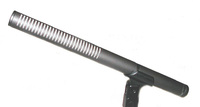Now let's examine the types of microphones we have to chose from.
Microphones can be defined by two sets of parameters: sensitivity and pattern.
In terms of sensitivity, there are three main categories that a microphone can fall into.
![]() Dynamic: Think of a dynamic microphone as a manual typewriter. The harder that your finger hits the key, the stronger the imprint. With a dynamic mic, the pressure of the sound waves moving the diaphragm actually generates electrical current (which is what the sound signal is). Dynamic mics are extremely rugged and do not require any form of battery powering. They are relatively insensitive to background noise (or feedback) and are commonly used as handheld performance mics and reporter’s mics.
Dynamic: Think of a dynamic microphone as a manual typewriter. The harder that your finger hits the key, the stronger the imprint. With a dynamic mic, the pressure of the sound waves moving the diaphragm actually generates electrical current (which is what the sound signal is). Dynamic mics are extremely rugged and do not require any form of battery powering. They are relatively insensitive to background noise (or feedback) and are commonly used as handheld performance mics and reporter’s mics.
A dynamic mic used close to the mouth will reject all but the loudest background noise, making them ideal for stand-up reporting (where the mic can be seen on camera) or narration recording (to eliminate as much background as possible). The example shown here is the Electro-Voice RE50, a longtime favorite of news reporters.
Dynamic mics tend to naturally compress loud noises, making them a good choice for recording explosive and crashing sound effects. A loud sound effect, unless carefully recorded, will tend to be "blown" right off of the recording tape, which is why real gunshots that leave your ears ringing only sound like dull pops on a videotape.
The downside to dynamic microphones is that they have very poor reach in terms of distance when it comes to dialogue. They are pretty much useless on a boom or fishpole.
Here is a tip: When filming an actor who is pretending to be a performer and will be seen using a handheld mic, it is much safer to consider the hand mic as merely a stage prop and to mic the actor with a boom or lavalier. Actors in those situations tend to gesture wildly with the mic, making your chances of getting good dialogue quite slim.
 The next most sensitive group of microphones are the electret condensers. Electret condenser microphones are like electric typewriters. These microphones operate off of a nominal voltage (usually 1.5 volts) which is derived from an internal battery such as an AA or button battery. The voltage that creates the audio signal comes from the battery (as opposed to being generated magnetically as in the case of dynamics); the relative sound levels control the capacitance, releasing voltage according to what the mic hears. Almost think of it like a meter that measures the sound, and releases a signal accordingly.
The next most sensitive group of microphones are the electret condensers. Electret condenser microphones are like electric typewriters. These microphones operate off of a nominal voltage (usually 1.5 volts) which is derived from an internal battery such as an AA or button battery. The voltage that creates the audio signal comes from the battery (as opposed to being generated magnetically as in the case of dynamics); the relative sound levels control the capacitance, releasing voltage according to what the mic hears. Almost think of it like a meter that measures the sound, and releases a signal accordingly.
Electret condenser mics offer much more sensitivity (range) than dynamics, and include what is commonly referred to as "ENG" grade shotgun mics as well as most lavaliers.
Examples of electret condenser shotgun mics include the Audio Technica AT897 (pictured), AT8015; and the Sennheiser K6/ME66 (or the older K3U/ME80). Lavaliers include the Sony ECM44/55/66/77, the Tram TR50, the Sennheiser MKE 2, and the Audio Technica AT803b , MT830R, AT899.
The third group of professional microphones are the true condenser type. Think of electronic word processors. Condenser shotgun mics are the most sensitive and offer the greatest working range for Production.
